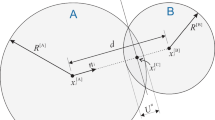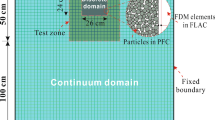Abstract
Based on the rapid impact compaction technique, the dynamic compaction process of gravel soil ground was simulated using the particle flow discrete element code PFC2D/PFC3D. The improvement effect and the influence depth of the dynamic compaction of the gravel soil foundation were analyzed based on the porosity variation of the foundation soil during the dynamic compaction process. The influences of the dynamic hysteretic effect, the values of the parameters for the contact model and the shape of the hammer on the computation results of the numerical analyses were analyzed. The feasibility of the numerical simulation for the dynamic compaction process of the gravel soil foundation was discussed. The computation results obtained by the particle flow discrete element method shows that the porosity variation induced by the particle spin must be considered in the numerical analysis of the dynamic compaction of gravel soil ground. The particle flow discrete element method is effective and reasonable in the numerical analysis of the dynamic compaction of gravel soil ground.











Similar content being viewed by others
References
Gu, Q., Lee, F.H.: Ground response to dynamic compaction of dry sand. Geotechnique 52, 481–493 (2002)
Scott, R.A., Pearce, R.W.: Ground Treatment by Deep Compaction. Institution of Civil Engineers, Telford, London (1976)
Thilakasiri, H.S., Gunaratne, M., Mullins, G., et al.: Investigation of impact stresses induced in laboratory dynamic compaction of soft soils. Int. J. Numer. Anal. Methods Geomech. 20, 753–767 (1996)
Lumay, G., Vandewalle, N.: Compaction of anisotropic granular materials: experiments and simulations. Phys. Rev. E 70, 1–5 (2004)
Lumay, G., Vandewalle, N.: Experimental study of the compaction dynamics for two-dimensional anisotropic granular materials. Phys. Rev. E 74, 1–8 (2006)
Knight, J.B., Fandrich, C.G., Lau, C.N., et al.: Density relaxation in a vibrated granular material. Phys. Rev. E 51, 3957–3963 (1995)
Richard, P., Nicodemi, M., Delannay, R., et al.: Slow relaxation and compaction of granular systems. Nat. Mater. 4, 121–128 (2005)
Caglioti, E., Loreto, V., Herrmann, H.J.: A “Tetris”-like model for compaction of dry granular media. Phys. Rev. Lett. 79, 1–4 (1997)
Vandewalle, N., Lumay, G., Gerasimov, O., et al.: The influence of grain shape, friction and cohesion on granular compaction dynamics. Eur. Phys. J. E 31, 1–8 (2007)
Kristiansen, H., Davies, M.: Ground improvement using rapid impact compaction. In: The 13th World Conference on Earthquake Engineering, Vancouver, Canada (2004), Paper No. 496
Serridge, C.J., Synac, O.: Application of the rapid impact compaction (RIC) technique for risk mitigation in problematic soils. In: The 10th IAEG International Congress, Nottingham, United Kingdom, pp. 1–13 (2006)
Mohammed, M.M., Hashim, R., Salman, A.F.: Effective improvement depth for ground treated with rapid impact compaction. Sci. Res. Essays 5, 2686–2693 (2010)
Sheng, D.C., Eigenbrod, K.D., Wriggers, P.: Finite element analysis of pile installation using large-slip frictional contact. Comput. Geotech. 32, 17–26 (2005)
Yu, L., Liu, J., Kong, X.J., et al.: Three-dimensional RITSS large displacement finite element method for penetration of foundations into soil. Comput. Geotech. 35, 372–382 (2008)
Harder, L.F., Seed, H.B.: Determination of penetration resistance for coarse-grained soils using the Becker hammer drill. Earthquake Engineering Research Center, Report No. UCB/EERC-8606 (1986)
Cundall, P.A., Strack, O.D.L.: A discrete numerical model for granular assemblies. Geotechnique 29, 47–65 (1979)
Cundall, P.A.: Numerical experiments on localization in frictional materials [J]. Ing. Arch. 59, 148–159 (1989)
Cheng, Y.P., Nakata, Y., Bolton, M.D.: Discrete element simulation of crushable soil. Geotechnique 53, 633–641 (2003)
Iwashita, K., Oda, M.: Rolling resistance at contacts in simulation of shear band development by DEM. J. Eng. Mech. 124, 285–292 (1998)
Wada, K., Senshu, H., Matsui, T.: Numerical simulation of impact cratering on granular material. Icarus 180, 528–545 (2006)
Sawamoto, Y., Tsubota, H., Kasai, Y., et al.: Analytical studies on local damage to reinforced concrete structures under impact loading by discrete element method. Nucl. Eng. Des. 179, 157–177 (1998)
Jiang, M.J., Yu, H.S., Harris, D.: Discrete element modelling of deep penetration in granular soils. Int. J. Numer. Anal. Methods Geomech. 30, 335–361 (2006)
Jiang, M.J., Zhu, H.H., Harris, D.: Classical and non-classical kinematic fields of two-dimensional penetration tests on granular ground by discrete element method analyses. Granul. Matter 10, 439–455 (2008)
ITASCA Consulting Group. Particle flow code in 2 dimensions, version 3.1, user’s manual. ITASCA Consulting Group, Minneapolis (1998)
ITASCA Consulting Group. Particle flow code in 3 dimensions, version 3.1, user’s manual. ITASCA Consulting Group, Minneapolis (1998)
Hardin, B.O., Drnevich, V.P.: Shear modulus and damping in soils: measurement and parameter effects. J. Soil Mech. Found. Eng. Div. ASCE 98, 603–624 (1972)
Seed, H.B., Wong, R.T., Idriss, I.M., et al.: Moduli and damping factors for dynamic analyses of cohesionless soils. J. Geotech. Eng. Div. ASCE 112, 1016–1032 (1986)
Sun, J.I., Golesorkhi, R., Seed, H.B.: Dynamic Moduli and Damping Ratios for Cohesive Soils. Earthquake Engineering Research Center, University of California, Berkeley (1988)
Acknowledgments
The research described in this paper was funded by the National Nature Science Foundation of China (Nos. 41172276, 51279155) and the scientific research foundation for the advanced talents (No. 118-211307). The data in this paper have not been presented anywhere.
Author information
Authors and Affiliations
Corresponding author
Rights and permissions
About this article
Cite this article
Ma, ZY., Dang, FN. & Liao, HJ. Numerical study of the dynamic compaction of gravel soil ground using the discrete element method. Granular Matter 16, 881–889 (2014). https://doi.org/10.1007/s10035-014-0529-x
Received:
Published:
Issue Date:
DOI: https://doi.org/10.1007/s10035-014-0529-x




